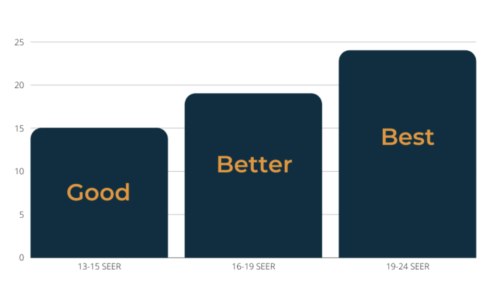What Does SEER Mean for Your HVAC System?
April 25, 2023
Facing the sweltering heat of the desert, your family needs an air conditioner that cools your home effectively. A hot day in Arizona with a low SEER rating AC is the cause of expensive summer energy bills. To select the right HVAC unit for your home, it’s important to understand the definition of SEER.
Our guide explains the meaning and importance of SEER rating in HVAC, helping you make an informed decision for cooling your home and saving money. If you’re in the market for a new HVAC system and looking for ways to save energy with your AC, consider working with Patrick Riley Cooling, Heating, and Plumbing to evaluate your home and its cooling needs.
SEER Definition
What does SEER mean in HVAC? SEER stands for Seasonal Energy Efficiency Ratio. Your SEER rating indicates how efficient your AC can be and how much energy is required to produce a certain level of cooling for your home.
To produce a SEER rating, the U.S. Department of Energy compares the AC’s input (watt-hours) with its output (BTUs per hour), providing homeowners with an apples-to-apples comparison of various unit options from different manufacturers.
- Definition of high SEER ratings: These units deliver greater energy efficiency, which is needed for homes in and around Central Phoenix. High SEER ratings (between 16–24 SEER) are better for the environment and save energy with ACs (meaning lower electricity bills).
- Definition of low SEER ratings (typically in units from the 1990s): These units are not energy efficient and may cause more humidity in the home.

SEER rating chart provided by HVAC.com
Why Does SEER Rating Matter?
Your SEER rating in HVAC determines the efficiency of your AC and helps your family save energy and money. Air conditioners consume energy, and their size and efficiency impact the cost of running the system. A correctly sized HVAC system may still use more electricity than necessary, increasing your monthly utility costs. In southwestern states like Arizona, efficiency is as vital as the size of the AC unit itself.
Call or contact Patrick Riley Cooling, Heating, & Plumbing in Phoenix today for AC recommendations that balance performance and cost savings and for more information about SEER rating.
SEER Rating in Arizona & How to Save Energy with ACs
For Arizonians, the recommended SEER rating is between 14–24 SEER. The SEER rating varies depending on the BTUs from an AC.
- ACs with less than 45,000 BTUs will need a SEER of at least 14.
- ACs with more than 45,000 BTUs require a SEER of 14.5.
Air conditioners with higher SEER ratings typically cost more up front, but they can save homeowners hundreds or even thousands of dollars in the long run. Choose a higher SEER AC to save energy and lower utility costs and to mitigate mold in the home.
Use the SEER Energy Savings Calculator to compare your current air conditioner with one that has a higher SEER rating.
Access Your Home’s Needs with Patrick Riley
Before summer arrives, call Patrick Riley Cooling, Heating, & Plumbing to find the right HVAC system for your home and for more definition around SEER rating. We explore the size of your home and your cooling needs to find and install the best AC unit with a high SEER rating. Our flexible financing makes new AC installation possible for Phoenix homeowners, helping them achieve their energy saving goals.
Written by: Patrick Riley Cooling, Heating, & Plumbing
Get 10% off (Up to $150)

Ty Lindsay is the Director of Field Operations at Patrick Riley | Isley’s and a 15-year veteran of the plumbing and HVAC trades. In 2010, Ty earned his Journeyman’s plumbing license. He became a Master Plumber five years later and earned his Journeyman HVAC technician’s license that same year. Ty’s breadth of knowledge in plumbing and HVAC includes both residential and commercial work. He’s been a loyal member of the Patrick Riley | Isley’s team since 2016.
- Posted in:
- Tips
